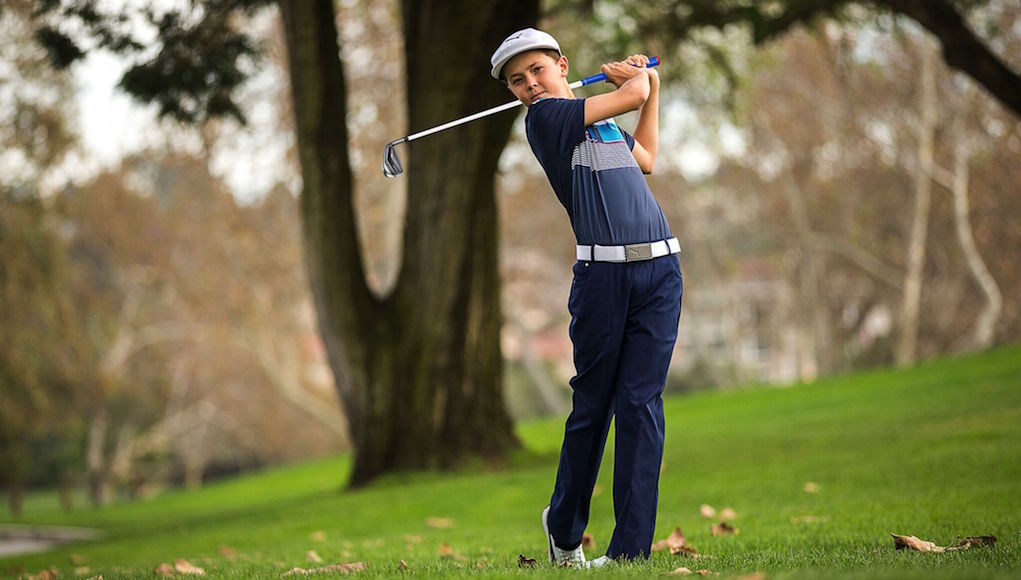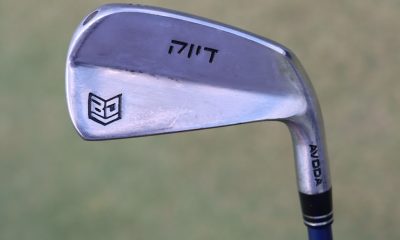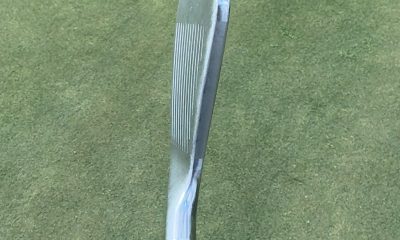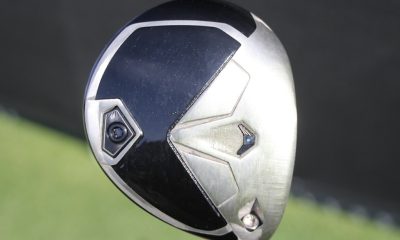Opinion & Analysis
Are Cobra’s F7 Junior One-Length Irons Good for Youth Golf?

Golf equipment companies that make clubs for junior golfers are in a difficult position. They need to look out for their business by turning profits, developing brand loyalty and ultimately making their customers happy. But these equipment companies also need to look out for the future of the sport, and get clubs in the hands of junior golfers that will properly develop their golf games.
As such, I want to have a conversation about Cobra’s new Junior F7 One irons, which are single-length golf clubs made for juniors aged 13-15 years old, and the possible consequences (negative or positive) of putting these clubs in their hands.
First, I’d like to commend Cobra on making a set of irons that may make the game easier for more junior golfers, and for being bold in its chase to simplify the game. The single-length iron sets were developed by Tom Olsavsky, the Vice President of R&D for Cobra, after thorough testing, study and input from Mike Schy, a proponent of The Golfing Machine theories and Bryson DeChambeau’s longtime swing coach. Although the single-length system is not widely accepted — not yet, at least — the concept of single-length irons is such that a golfer doesn’t need to change his/her swing between irons because they’re all the same length, weight and have the same lie angle. To make the golf ball go different distances, single-length irons clubs use different lofts and head designs. That certainly can simply things.
Junior golf equipment has come a long way from the days of simply cutting down adult sets, or using your father’s hand-me-downs. There are now many different options for golfers of different sizes and strengths, and that’s a wonderful thing. Also, Cobra gave these particular irons serious engineering attention and similar technologies as the adult, one-length sets.
Like the adult versions, the F7 Junior One irons have TechFlo — a technology designed to help the longer irons fly higher and farther — and they also have PwrShell faces, which means they are thinner and more forgiving across the face. The grooves are milled and designed to produce the proper spin for each individual iron. The clubs come stock with Lamkin EPDM REL-Red, White and Blue grips and graphite Fujikura Fuel Junior shafts (36.25 inches in length), and they come in a five-piece set (5-7-9-PW-SW) that sells for $449 available now at retail and online.
I question the effectiveness of buying a single-length club for a junior golfer who’s 13-15 years old — a fairly wide range of physical characteristics there — without getting fit, but that’s another argument for a different day. My particular worry is for junior golfers who plan to take the game seriously, and have hopes of competing in high school and attaining a college scholarship. Along with the benefits, there could be longterm drawbacks of using single-length irons at a young age.
As a former NCAA Division I golfer who used progressive, or “normal” length irons his entire career, I had a mostly positive experience with the single-length irons — for which I was fully fitted — during my experiment for a GolfWRX review. I’ve since switched back to a normal-length set of irons because of the limitations I felt with trajectory and distance control; the more time went on, the more I felt long irons went too low and short irons went too high. My shotmaking was also suffering around the greens.
For me, using single-length irons was an experiment that I underwent by choice, and switching back to “normal” irons was natural because my swing and mentality had developed using progressive-length irons. My fear for junior golfers ages 13-15 who are given a set of single-length clubs is that their swings would be ingrained under the single-length concept… a concept that isn’t necessarily for everyone. Junior golfers in the developing stage of their bodies and swings are impressionable, and switching back from the single-length set into normal length irons later in life could prove difficult. Also, their shotmaking could be sacrificed in the short- and long-run.
I spoke to top-100 fitter Scott Felix of Felix Clubworks, and Ryan Johnson, the 2015 Michigan Amatuer champion and a fitter at Carl’s Golfland, for their expert opinions on the topic. Felix said while the single-length system could be beneficial using the relatively shorter 5 iron in terms of contacting the center of the face more consistently — but not in creating more speed — the longer wedges may take away from touch and feel around the greens. He said while he wouldn’t necessarily recommend single-length irons to a junior golfer, he would evaluate their performance with the clubs and help the junior get what they play the best. Johnson added that the single-length system may be easier since it’s only one swing in theory, but that the system might work best for a one-plane type swing (which The Golfing Machine calls a “zero shift”) and for junior golfers who understand and embrace the concept. As an accomplished player himself, Johnson once tried the one-length system and found difficulty with the short irons and wedges because they flew too high and to the left, and said “I couldn’t even think about hitting a bunker shot with them.”
“I wouldn’t tell a junior golfer or a parent not to (buy a single-length set),” Johnson said. “I’d just give them a rundown of the concept and what it entails.”
Olsavsky, on the other hand, doesn’t see a downside to the single-length system. “If a kid can hit a 7-iron, [he or she] can hit every club in the bag,” he says, and that one-length irons will ultimately put less stress on the mind and body throughout a junior’s life if they stick to one-length irons. He described a short game test that Cobra performed on one-length wedges vs. normal-length wedges, where a group of 2-12 handicappers hit 20- and 30-yard shots, as well as a chip shot and a flop shot. The results of the test showed that shots hit with single-length wedges finished closer to the hole and were more preferred in three of the four locations.
Regardless of performance, however, junior golfers are influenced heavily by what they see on TV or what their friends are doing.
“Since working with Bryson DeChambeau to help bring this concept to life in two adult sets of irons earlier this year, we have had requests from retailers and consumers to offer a set of one-length irons for junior golfers,” Olsavsky said in a press release.
So let’s say a junior’s favorite golfer is Bryson DeChambeau and they see him using single-length irons. Obviously, they ask their parents to buy them a set of single-length irons because it’s “cool.”
Parents should proceed with caution here. If a child wants to compete at a high level, it’s a bigger decision than simply saying, “Oh, this is what the kid says he wants so I’m going to buy it for him.” Let’s remember, DeChambeau himself grew up using a conventional length set of irons and later switched.
That’s not to say single-length is the wrong decision, either. Some kids will absolutely thrive under a single-length system, and in turn have confidence they wouldn’t have otherwise. The game may be simplified and come easier for the junior golfer because of it, and make golf fun.
For others, their development may be stunted. That’s why seeking professional guidance in this circumstance is so crucial.

Cobra has this to say about the performance aspects of the clubs.
“We tested these irons among a wide range of skill levels ranging in age from 13-15 and we found that universally they delivered more consistency and better performance for these younger golfers,” Olavsky said in a press release.
Personally, I don’t doubt that to be the case. In a vacuum, the irons surely perform really well (it’s more of the long-term effects that have me nervous).
Let me make this clear: I’m not bashing Cobra for providing single-length irons as an OPTION for the youth, I’m simply warning parents and junior golfers that the decision to buy these clubs is an important one. It will have lasting effects, whether positive or negative. Before buying a set of single-length irons for a junior golfer, please have this conversation with them under the supervision of a professional fitter or teaching professional.
We don’t want to rob golf of the next Justin Thomas just because he/she idolizes Bryson DeChambeau, or vice versa.
Opinion & Analysis
The 2 primary challenges golf equipment companies face

As the editor-in-chief of this website and an observer of the GolfWRX forums and other online golf equipment discourse for over a decade, I’m pretty well attuned to the grunts and grumbles of a significant portion of the golf equipment purchasing spectrum. And before you accuse me of lording above all in some digital ivory tower, I’d like to offer that I worked at golf courses (public and private) for years prior to picking up my pen, so I’m well-versed in the non-degenerate golf equipment consumers out there. I touched (green)grass (retail)!
Complaints about the ills of and related to the OEMs usually follow some version of: Product cycles are too short for real innovation, tour equipment isn’t the same as retail (which is largely not true, by the way), too much is invested in marketing and not enough in R&D, top staffer X hasn’t even put the new driver in play, so it’s obviously not superior to the previous generation, prices are too high, and on and on.
Without digging into the merits of any of these claims, which I believe are mostly red herrings, I’d like to bring into view of our rangefinder what I believe to be the two primary difficulties golf equipment companies face.
One: As Terry Koehler, back when he was the CEO of Ben Hogan, told me at the time of the Ft Worth irons launch, if you can’t regularly hit the golf ball in a coin-sized area in the middle of the face, there’s not a ton that iron technology can do for you. Now, this is less true now with respect to irons than when he said it, and is less and less true by degrees as the clubs get larger (utilities, fairways, hybrids, drivers), but there remains a great deal of golf equipment truth in that statement. Think about it — which is to say, in TL;DR fashion, get lessons from a qualified instructor who will teach you about the fundamentals of repeatable impact and how the golf swing works, not just offer band-aid fixes. If you can’t repeatably deliver the golf club to the golf ball in something resembling the manner it was designed for, how can you expect to be getting the most out of the club — put another way, the maximum value from your investment?
Similarly, game improvement equipment can only improve your game if you game it. In other words, get fit for the clubs you ought to be playing rather than filling the bag with the ones you wish you could hit or used to be able to hit. Of course, don’t do this if you don’t care about performance and just want to hit a forged blade while playing off an 18 handicap. That’s absolutely fine. There were plenty of members in clubs back in the day playing Hogan Apex or Mizuno MP-32 irons who had no business doing so from a ballstriking standpoint, but they enjoyed their look, feel, and complementary qualities to their Gatsby hats and cashmere sweaters. Do what brings you a measure of joy in this maddening game.
Now, the second issue. This is not a plea for non-conforming equipment; rather, it is a statement of fact. USGA/R&A limits on every facet of golf equipment are detrimental to golf equipment manufacturers. Sure, you know this, but do you think about it as it applies to almost every element of equipment? A 500cc driver would be inherently more forgiving than a 460cc, as one with a COR measurement in excess of 0.83. 50-inch shafts. Box grooves. And on and on.
Would fewer regulations be objectively bad for the game? Would this erode its soul? Fortunately, that’s beside the point of this exercise, which is merely to point out the facts. The fact, in this case, is that equipment restrictions and regulations are the slaughterbench of an abundance of innovation in the golf equipment space. Is this for the best? Well, now I’ve asked the question twice and might as well give a partial response, I guess my answer to that would be, “It depends on what type of golf you’re playing and who you’re playing it with.”
For my part, I don’t mind embarrassing myself with vintage blades and persimmons chasing after the quasi-spiritual elevation of a well-struck shot, but that’s just me. Plenty of folks don’t give a damn if their grooves are conforming. Plenty of folks think the folks in Liberty Corner ought to add a prison to the museum for such offences. And those are just a few of the considerations for the amateur game — which doesn’t get inside the gallery ropes of the pro game…
Different strokes in the game of golf, in my humble opinion.
Anyway, I believe equipment company engineers are genuinely trying to build better equipment year over year. The marketing departments are trying to find ways to make this equipment appeal to the broadest segment of the golf market possible. All of this against (1) the backdrop of — at least for now — firm product cycles. And golfers who, with their ~15 average handicap (men), for the most part, are not striping the golf ball like Tiger in his prime and seem to have less and less time year over year to practice and improve. (2) Regulations that massively restrict what they’re able to do…
That’s the landscape as I see it and the real headwinds for golf equipment companies. No doubt, there’s more I haven’t considered, but I think the previous is a better — and better faith — point of departure when formulating any serious commentary on the golf equipment world than some of the more cynical and conspiratorial takes I hear.
Agree? Disagree? Think I’m worthy of an Adam Hadwin-esque security guard tackle? Let me know in the comments.
@golfoncbs The infamous Adam Hadwin tackle ? #golf #fyp #canada #pgatour #adamhadwin ? Ghibli-style nostalgic waltz – MaSssuguMusic
Podcasts
Fore Love of Golf: Introducing a new club concept

Episode #16 brings us Cliff McKinney. Cliff is the founder of Old Charlie Golf Club, a new club, and concept, to be built in the Florida panhandle. The model is quite interesting and aims to make great, private golf more affordable. We hope you enjoy the show!
Opinion & Analysis
On Scottie Scheffler wondering ‘What’s the point of winning?’

Last week, I came across a reel from BBC Sport on Instagram featuring Scottie Scheffler speaking to the media ahead of The Open at Royal Portrush. In it, he shared that he often wonders what the point is of wanting to win tournaments so badly — especially when he knows, deep down, that it doesn’t lead to a truly fulfilling life.
View this post on Instagram
“Is it great to be able to win tournaments and to accomplish the things I have in the game of golf? Yeah, it brings tears to my eyes just to think about it because I’ve literally worked my entire life to be good at this sport,” Scheffler said. “To have that kind of sense of accomplishment, I think, is a pretty cool feeling. To get to live out your dreams is very special, but at the end of the day, I’m not out here to inspire the next generation of golfers. I’m not out here to inspire someone to be the best player in the world, because what’s the point?”
Ironically — or perhaps perfectly — he went on to win the claret jug.
That question — what’s the point of winning? — cuts straight to the heart of the human journey.
As someone who’s spent over two decades in the trenches of professional golf, and in deep study of the mental, emotional, and spiritual dimensions of the game, I see Scottie’s inner conflict as a sign of soul evolution in motion.
I came to golf late. I wasn’t a junior standout or college All-American. At 27, I left a steady corporate job to see if I could be on the PGA Tour starting as a 14-handicap, average-length hitter. Over the years, my journey has been defined less by trophies and more by the relentless effort to navigate the deeply inequitable and gated system of professional golf — an effort that ultimately turned inward and helped me evolve as both a golfer and a person.
One perspective that helped me make sense of this inner dissonance around competition and our culture’s tendency to overvalue winning is the idea of soul evolution.
The University of Virginia’s Division of Perceptual Studies has done extensive research on reincarnation, and Netflix’s Surviving Death (Episode 6) explores the topic, too. Whether you take it literally or metaphorically, the idea that we’re on a long arc of growth — from beginner to sage elder — offers a profound perspective.
If you accept the premise literally, then terms like “young soul” and “old soul” start to hold meaning. However, even if we set the word “soul” aside, it’s easy to see that different levels of life experience produce different worldviews.
Newer souls — or people in earlier stages of their development — may be curious and kind but still lack discernment or depth. There is a naivety, and they don’t yet question as deeply, tending to see things in black and white, partly because certainty feels safer than confronting the unknown.
As we gain more experience, we begin to experiment. We test limits. We chase extreme external goals — sometimes at the expense of health, relationships, or inner peace — still operating from hunger, ambition, and the fragility of the ego.
It’s a necessary stage, but often a turbulent and unfulfilling one.
David Duval fell off the map after reaching World No. 1. Bubba Watson had his own “Is this it?” moment with his caddie, Ted Scott, after winning the Masters.
In Aaron Rodgers: Enigma, reflecting on his 2011 Super Bowl win, Rodgers said:
“Now I’ve accomplished the only thing that I really, really wanted to do in my life. Now what? I was like, ‘Did I aim at the wrong thing? Did I spend too much time thinking about stuff that ultimately doesn’t give you true happiness?’”
Jim Carrey once said, “I think everybody should get rich and famous and do everything they ever dreamed of so they can see that it’s not the answer.”
Eventually, though, something shifts.
We begin to see in shades of gray. Winning, dominating, accumulating—these pursuits lose their shine. The rewards feel more fleeting. Living in a constant state of fight-or-flight makes us feel alive, yes, but not happy and joyful.
Compassion begins to replace ambition. Love, presence, and gratitude become more fulfilling than status, profits, or trophies. We crave balance over burnout. Collaboration over competition. Meaning over metrics.
Interestingly, if we zoom out, we can apply this same model to nations and cultures. Countries, like people, have a collective “soul stage” made up of the individuals within them.
Take the United States, for example. I’d place it as a mid-level soul: highly competitive and deeply driven, but still learning emotional maturity. Still uncomfortable with nuance. Still believing that more is always better. Despite its global wins, the U.S. currently ranks just 23rd in happiness (as of 2025). You might liken it to a gifted teenager—bold, eager, and ambitious, but angsty and still figuring out how to live well and in balance. As much as a parent wants to protect their child, sometimes the child has to make their own mistakes to truly grow.
So when Scottie Scheffler wonders what the point of winning is, I don’t see someone losing strength.
I see someone evolving.
He’s beginning to look beyond the leaderboard. Beyond metrics of success that carry a lower vibration. And yet, in a poetic twist, Scheffler did go on to win The Open. But that only reinforces the point: even at the pinnacle, the question remains. And if more of us in the golf and sports world — and in U.S. culture at large — started asking similar questions, we might discover that the more meaningful trophy isn’t about accumulating or beating others at all costs.
It’s about awakening and evolving to something more than winning could ever promise.






















Bruce
May 19, 2017 at 9:21 am
Written from an OEM perspective; that is, throw away a good idea to preserve the business profits. Quit bringing up red herring non-issues for marketing reasons. If we all played single length and someone introduced variable length, what an uproar that would cause. Golf is a marketing driven business: very very little science (I am a PhD Mechanical Engineer who understands golf science). Single length irons make good sense. Multiple length irons and swing weight matching HAVE NO BASIS IN SCIENCE. These are all marketing.
Mat
May 20, 2017 at 7:29 pm
Actually, multi-length irons have plenty of basis in science. They use length of shaft as one of two main properties that provide distance gaps between irons. By doing this, they can achieve a more consistent descent angle, apex, and distance range within a set.
These are the issues that SLI are working hard to overcome. There have been advancements, but that doesn’t mean they’re perfect. But for a ME PhD to go on about how MLI have no basis is ignorant.
Dave R
Apr 26, 2017 at 10:07 pm
Ken I think you need a hug.
Eddie
Apr 26, 2017 at 6:32 pm
Talent will always trump equipment. No piece of equipment will ever make or break someone’s golf career.
The dude
Apr 26, 2017 at 4:55 pm
What I don’t understand….why it takes someone forever to share their thoughts on a post. If it’s longer than 5 lines…just read the last sentence….
Scott
Apr 26, 2017 at 4:06 pm
Just because you have a different grip with different clubs does not mean everyone else does. And just how many 6′ 4″ juniors do you come across? Wow.
Philip
Apr 26, 2017 at 2:29 pm
They are if you are an OEM that wants to start a new batch of players that will not have an enormous supply of cheaper used clubs to pick from once they grow up and can spend their own money.
cody
Apr 26, 2017 at 1:18 pm
I have a 5 year old girl that i would like to get into golf. I will be honest i dont see a donw side to single length irons to start with. Are you all really saying that a kid cannot switch to more traditional clubs at some point?? c’mon man!!!
Mat
Apr 26, 2017 at 4:09 am
Navel gazing. If a kid is starting out, they get a lower learning curve. Fantastic.
What makes anyone think that the equipment they had as a 14 year old will affect them as an adult? Seriously, if you’re talking about things like apex height and swing weight to a 14 year old, not only is it a relevant conversation, let them choose themselves!
This product is designed for Daddy Upper-middle-class to give to his kid as a starter set that does not suck. This is not, at all, for serious kids. The serious kid MIGHT strip the crap shaft and play something else if they want SLI, but you’re talking a few very good kids with parental bankroll.
Arguing against quality options for kids is not growing the game. It’s the opposite.
AussieAussieAussie
Apr 26, 2017 at 12:35 am
I still can not understand why so many people hate the idea of single length irons? If a kid starts out playing golf with a single length set in years to come- when they have made them for the 3-5yr old age groups, then he or she will know no different than to use single length, to them varying length could be a foreign and ridiculous concept. Ultimately we want to as golfers grow the game- however that be. Relaxed dress codes, cheaper big name brand clubs more realist available, so why not just embrace the change, I’m sure hybrids and lob wedges were seen as a fad at the time of establishment? Yet here we are with most of us having one or both in our bag?! If one length works great, if it doesn’t that’s also fine! I wouldn’t expect you all to go swing like Jim Fuyrk just because it works for him. It’s not likely to work for you but no one begrudges him his success as a result of it?!
Ken
Apr 26, 2017 at 12:09 am
I bought a set of Tommy Armour EQLs many years ago and got rid of them for that exact reason. I couldn’t use my 7 iron left hand grip for the other clubs and particularly for the low loft clubs. Junior golfers who try to use these clubs will limit their progress and likely never make it into the pro tours.
Scott
Apr 26, 2017 at 4:04 pm
That is quite a leap to think that someone starting the game should not start with an easier system, then move into a different set that may work better for them down the road. I started with blades and persimmon woods – certainly a world of difference over today’s equipment.
Andrew you could not be any more wrong.
Scott
Apr 26, 2017 at 4:04 pm
Ken,
As if you could even know that.
Prime21
Apr 25, 2017 at 9:07 pm
It’s like everything else in golf, it will work for some, not for others. Hopefully Cobra is willing to supply a Demo Set so that Juniors could test them out prior to purchasing. Wishful thinking, but a thought!
Ken
Apr 26, 2017 at 12:12 am
Good junior golfers will never adapt to the single length/single shaft lie clubs because it will be too frustrating for younger minds to go through the trial and error phase of conversion.
Scott
Apr 26, 2017 at 4:10 pm
Ken,
Juniors are probably the BEST at going through a learning phase because they can look at things with an open mind and have not been influenced by people such as yourself.
RI_Redneck
Apr 25, 2017 at 8:48 pm
IMHO:
Shafts should have been steel.
Heads should have adjustable weights to adjust for longer lengths for varying heights and as the kid grows.
Price should be lower (steel shafts hep here).
It would have AT LEAST offered length options based on the kids height. Overlooking this greatly hamstrings Cobra’s ability to market these to the young masses. 13-15 yr olds height can vary A LOT. Good concept, but poor marketing.
BT
Steve
Apr 25, 2017 at 2:11 pm
Why is nobody complaining about the insane cost? This is at least at the same cost as a set of regular irons $90 per. How can that ever be good for junior golf?
mvhoffman
Apr 25, 2017 at 2:00 pm
I just have a feeling that these will continue to be developed. Players will soon start to play these from the start of their golf “career”. The USGA will wait, and wait, and wait…. and wait… just like they did with the belly putter, and then find a loophole to take these away and destroy more careers… I’m going to start a thread on this.
Ken
Apr 26, 2017 at 12:16 am
Parents who buy such clubs for their aspiring amateur golfer and hopefully a golf scholarship are only trying to cover up the swing faults of their child. That’s the only reason an adult will buy them too. An expensive band-aid remedy for a poor swing with regular clubs.
Brandon
Apr 26, 2017 at 4:58 pm
Ok, you can say whatever you want, but don’t you even dare thinking about using a putter that isn’t a blade. On that note, trade in your 460 cc driver for a good old fashioned steel shaft 975D driver, as current day drivers are also an “expensive band-aid for a poor swing”.
Tom 1
Apr 25, 2017 at 11:24 am
Yes